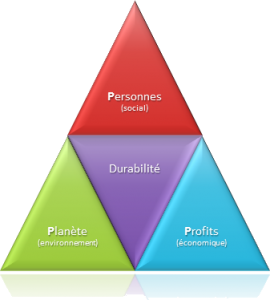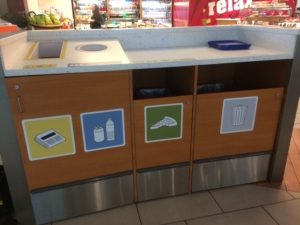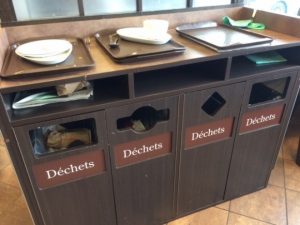
Name the top 5 responsible franchises according to you. Why do they invest in sustainable development? What are your customers’ expectations with regard to sustainable development (SD)? Whether you are a franchisor or a franchisee, your primary mission is to deliver the best customer experience, i.e. to meet your customers’ expectations. Thus by ignoring the growing interest among consumers for SD, a banner takes a big risk. Moreover, this shift towards sustainability can help achieve significant savings in your operating costs.

Inspiring examples!
• Première Moisson’s 4 pillars of social responsibility are: products, community, environment and employees. One of the franchises in Montreal carried out an innovative project for the optimization of operations and energy efficiency, and as a result achieved annual energy savings of about 70%. (1)
• Starbucks is part of Montreal’s youth day project to help young people enter the job market. On this day, each employee is also encouraged to volunteer in their community (2). While there are no direct savings, this investment in social responsibility and sustainability can prove very profitable in the long term since Quebecers aged 18 to 24 now top the list of the most environmentally responsible age groups. (3)
What do your customers expect?
• According to a study by the Observatoire de la Consommation Responsable, consumers look for products with smaller environmental footprint from the point of view of ingredients and production (…) The number of green consumers in Quebec is up, 21.4% have a sustainable consumption index above 80 out of 100 (4).
• Quebecers use eco-friendly products and services primarily for their environmental, health and social benefits. (5)
What’s in it for you?
1) A growing number of competitors enforce cost-saving strategies in their networks. To offset the augmentation in the cost of food and commercial lease, such network-wide strategies can influence the bottom line profits. Examples: cutting energy and water consumption, and reducing waste allow for recurring earnings.
2) Most networks have relatively high employee turnover. It is difficult to attract qualified workers. The younger generations increasingly seek job opportunities in companies that share their values.
3) Franchisors with sound practices are keen on achieving profitability for everyone in the network. Better financial results also make recruiting new franchisees easier. Better profitability results ensure the sustainability of the network, which thus continues to create jobs.
Does it apply to your banner? Who is to commit, on the franchisor or franchisee side? In our article “The Strength of Franchising”, we talked about the importance for franchisors and franchisees to share the same values. Franchisors must build a strong network culture, implement sound practices and apply quality methods, and they must make sure that everything is well documented to ensure successful knowledge transfer. For their part, franchisees must be autonomous and ensure the financial health of their business. So, how do you integrate SD?
Franchise networks are different from the corporate world where the head office issues guidelines to be first tested in a pilot project at one of the divisions and then, if proven viable, to be applied throughout the company. So to make your sustainable organizational improvement project a success, it is important to:
1) Make sure your franchisees are fully engaged and committed. Otherwise your efforts will become part of the sad statistics showing that 70% of projects fail. Any SD initiative must come with a sound change implementation strategy.
2) Go step by step. There is no added value in trying to execute large-scale projects all together. A smaller project that can be completed in a short timeframe can be put into action at 1 or 2 points of service, for example. If the savings are confirmed, the implementation can be extended across the network before embarking on the next project, and so on. Nothing can boost the enthusiasm and drive to be “responsible and sustainable” more than a successful project.
3) After the implementation, make sure that the operational processes are adapted and the employees are well aware. Here are some examples that unfortunately can have a negative impact on the anticipated cost savings, and even cast a shadow on the brand image.
a. Conscious consumers who take the trouble to bring their reusable cups are taken aback when they are handed an empty paper cup to enter a contest or to accumulate points.
b. Overpacking your products or overusing cleaning agents just because they are green will make people question your methods.
c. As a customer or employee, which of the following images better represents your values?


Moreover, to deliver a strong consistent message your must effectively communicate and raise awareness of your efforts. In other words, when the franchisor pledges the commitment of all the restaurants in the network to the SD principles, if there is no clear understanding and support on the part of each and every employee, the overall customer experience will suffer.
Whether you are in the retail, food or health industry, a strong commitment to sustainable development in the context of strategic planning will add value to your offer. The Totem team can help you identify and prioritize your top projects, and support you in their implementation till the achievement of savings.
References: (1) Corporate Responsibility – Première Moisson: https://premieremoisson.com/en/corporate-responsability (2) Starbucks Global Responsibility Report 2013
https://globalassets.starbucks.com/assets/b48b38aed56e4fdd8dcdbbfad23e3242.pdf
Starbucks’ Social Responsibility and Sustainability
https://www.starbucks.ca/responsibility (3) https://www.protegez-vous.ca/Nouvelles/Affaires-et-societe/La-consommation-responsable-est-elle-encore-a-la-mode
(4) http://consommationresponsable.ca/wp-content/uploads/2016/11/Barom%C3%A8tre-2016-final.pdf
(5) http://consommationresponsable.ca/wp-content/uploads/2013/11/OCR-La-valorisation-par-les-Qu%C3%A9b%C3%A9cois-de-l%C2%B9engagement-responsable-des-d%C3%A9taillants.pdf
Par Marie-Josée Roy, ing., M.Env.
Experte gestion stratégique, performance et durabilité
Totem Performance organisationnelle